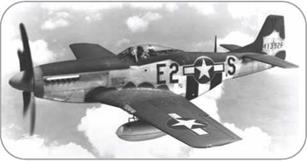Bombing Day and Night
In daylight raids, bombers suffered high losses from fighter attacks and also from anti-aircraft gunnery, and so they
|
О The P-51 Mustang, like the Spitfire, became a legendary fighter aircraft during World War II. |
switched to night attacks. In the early part of the war, no air force was well equipped for night fighting. Pilots had little chance of spotting an enemy plane in the dark until the invention of
airborne radar changed night fighting into a battle of technologies. Most night fighters had a crew of two: a pilot and a radar operator. Typical night fighters were twin-engine airplanes such as the German Me-110, British Beaufighter, and U. S. P-61 Black Widow.
The Allies built up their bombing attacks. The RAF bombed at night, using “pathfinder” planes flying ahead of the main force to locate and illuminate target areas. The U. S. Army sent big formations of bombers in daylight to pound selected targets. Starting in 1942, the U. S. Eighth Army Air Force flew missions across Europe from bases in Britain. U. S. commanders, such as Colonel Curtis LeMay, were confident that their bombers—bristling with machine guns—could fight their way to and from the target, especially when shielded by fighter escorts. The P-51 Mustang, the best U. S. fighter of the war, could fly with the bombers from Britain to Berlin, Germany, and back. By 1943, U. S. bombers were flying to Germany in combat wings of fifty-four planes. They flew in formations over 1 mile (1.6 kilometers) across. As more escort fighters became available, these formations were cut to thirty-six planes, flying in four groups of nine.











